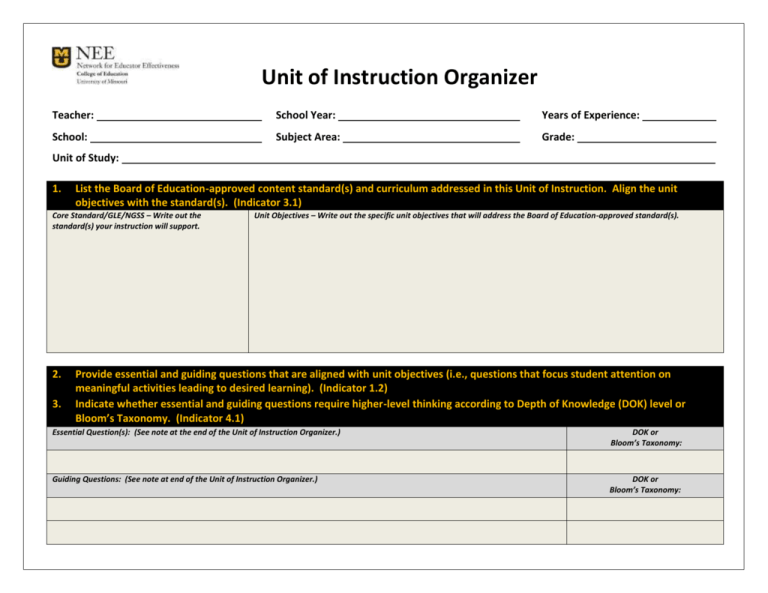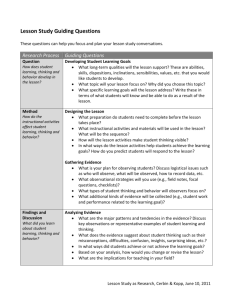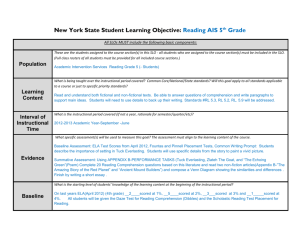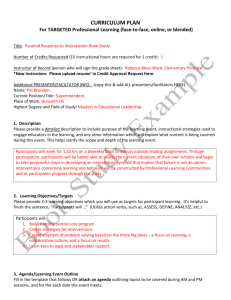
Unit of Instruction Organizer
Teacher:
School Year:
Years of Experience:
School:
Subject Area:
Grade:
Unit of Study:
1.
List the Board of Education-approved content standard(s) and curriculum addressed in this Unit of Instruction. Align the unit
objectives with the standard(s). (Indicator 3.1)
Core Standard/GLE/NGSS – Write out the
standard(s) your instruction will support.
2.
3.
Unit Objectives – Write out the specific unit objectives that will address the Board of Education-approved standard(s).
Provide essential and guiding questions that are aligned with unit objectives (i.e., questions that focus student attention on
meaningful activities leading to desired learning). (Indicator 1.2)
Indicate whether essential and guiding questions require higher-level thinking according to Depth of Knowledge (DOK) level or
Bloom’s Taxonomy. (Indicator 4.1)
Essential Question(s): (See note at the end of the Unit of Instruction Organizer.)
DOK or
Bloom’s Taxonomy:
Guiding Questions: (See note at end of the Unit of Instruction Organizer.)
DOK or
Bloom’s Taxonomy:
NOTE: To add another table row, select “Layout” in Table Tools and then “Insert Above” or “Insert Below.”
4.
Indicate how the Unit of Instruction elements link directly to the unit objectives. (Indicator 3.1)
What will students be asked to do? (e.g., learner activities, student work samples, and assessments)
Which unit objective does this support?
NOTE: Place documentation in Appendices A, B, and C.
NOTE: To add another table row, select “Layout” in Table Tools and then “Insert Above” or “Insert Below.”
5.
Describe the process of formative assessment to inform change in instruction to meet student needs and summative assessment to
evaluate student learning. (Indicator 7.2)
What formative assessment(s) will you use?
Describe how results of formative assessment(s) inform changes in instruction to meet student needs.
What summative assessment(s) will you use?
Describe how results of summative assessment(s) will be used to evaluate student learning. (How will you know the students met the learning objectives? Why are you giving that
particular assessment? What will it tell you?)
NOTE: Place documentation in Appendix D.
6.
Identify effective research-based instructional strategies to be used in the unit. (Indicator 2.3)
Explain why you are using specific instructional strategies. You do not need to discuss all the instructional strategies. Provide a description of key instructional strategies you will use
and which lessons you will use them in. Provide evidence of their effectiveness. Cited evidence should be from credible sources, such as publications or presentations that have been
reviewed by peers. Other examples include credible textbooks, trade books, journals, the What Works Clearinghouse review, and publications and papers produced by nationallyrecognized research or higher-education institutions.
7.
Describe the instructional strategies you will use to differentiate instruction for diverse learners present in the classroom. Mark
diverse learner categories that do not apply as “N/A” (Not Applicable). (Indicator 3.2)
Enrichment for accelerated learners:
Remediation for struggling learners (Tier 2/Tier 3):
ELL:
Other:
8.
Describe how you lead students to self-reflect about their personal goals regarding the unit objectives. (Indicator 2.2)
Provide description with evidence.
NOTE: Place documentation in Appendix C.
9.
Provide supporting resources used in the Unit of Instruction to guide both teacher and students. (Indicator 4.2)
How are you getting your end results? Provide description of supporting resources. Include samples, such as comparative student work samples/anchor papers, schedules/pacing
guides, task outlines, scoring guides/rubrics, assessments, or other appropriate resources for instruction and learning.
NOTE: Place documentation in Appendix E.
10.
Indicate how you will use available and appropriate technology to promote student engagement and learning. (Indicator 4.2)
Describe how each use of technology promotes engagement and/or deepens understanding. (See note at the end of the Unit of Instruction Organizer.)
Attach the following appendices A through E.
Appendix A: Lesson Sequence – This section should contain an overview or outline of unit lessons (scope and sequence).
Appendix B: Sample Lesson Plans – This section should contain samples of at least three class periods of lesson plans, including lesson objectives,
student activities, and differentiated instructional strategies.
Appendix C: Sample Formative and Summative Assessments
Appendix D: Sample Student Work – This section should contain a range of student work from an accelerated student to a struggling student.
Appendix E: Resources & Materials
REFERENCE NOTE FOR #2 and #3:
Essential question(s) target the unit objective(s) and frame the UOI learning goal. These questions promote higher-level thinking and deep, enduring understanding.
These cannot be answered in one sentence, and set the stage for further questions. These are open-ended, arguable, complex, meaningful to students’ real lives, and
relate to problems in the classroom. These form the basis of inquiry-based learning. These serve as an umbrella for other guiding questions and are complex enough to
be broken down into smaller, guiding questions. The following are examples of essential questions:
What is identity?
What is revolution?
What is healthful eating?
How should this be modeled?
How are the four basic math operations related to each other?
How do writers draw in readers?
How do animals change? (Early Childhood Education)
What are numbers? (Early Childhood Education)
Guiding question(s) are more detailed questions that support the essential question. These questions assist the learner in answering the essential question(s) and
cannot be answered in one sentence. These questions promote quality discussions and may lead to new questions. The following are examples of guiding questions:
Who caused this?
Who is involved?
Why did this happen?
REFERENCE NOTE FOR #10:
Note that this element is about using technology to enhance engagement and learning, not merely using technology. It is possible that technology could be
extensively used, but in a perfunctory way that does not meet this criteria. Engagement could refer to behavioral, cognitive, or affective engagement. The latter may
be more important for promoting learning, so be careful not to overemphasize behavioral engagement. Behavioral engagement refers to observable time-on-task,
compliance, and participation in a learning activity. Cognitive engagement refers to mental effort, such as concentration, meaningful processing, and monitoring one’s
thinking during a learning activity. Affective engagement refers to feeling interested, proud, excited, happy, and amused during a learning activity.
© Copyright 2014 by the Curators of the University of Missouri. All rights reserved. No part of this work may be reproduced or transmitted
by any means.









